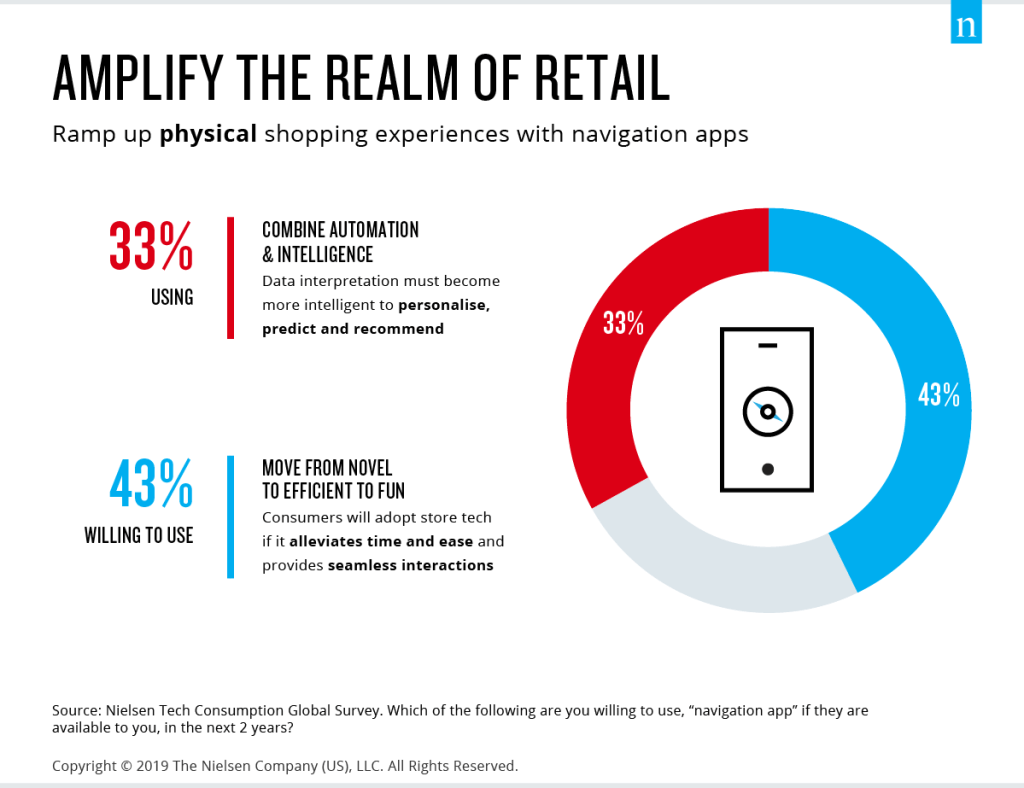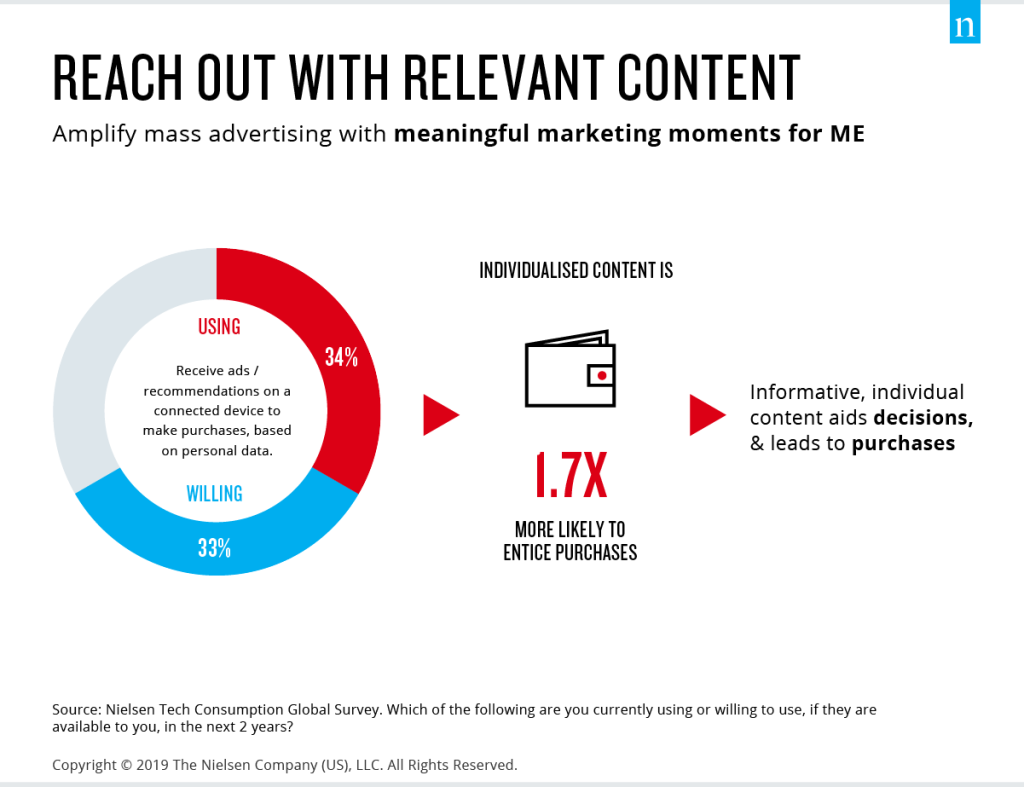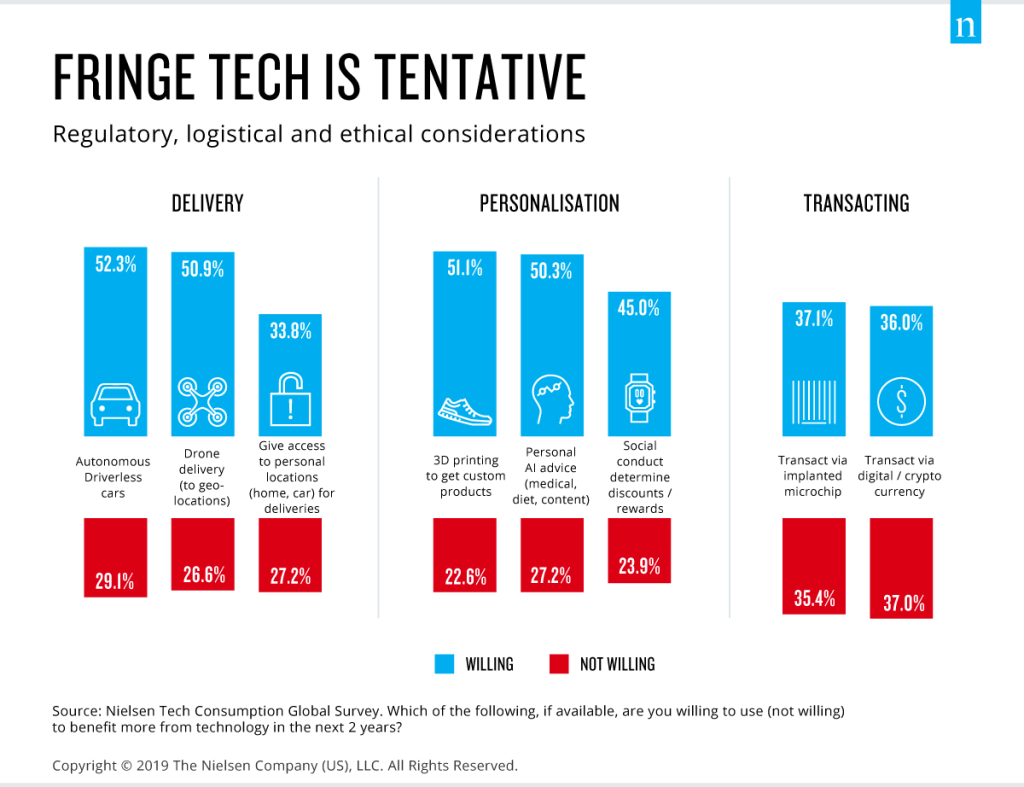Consumers today are increasingly craving immersive, real-life experiences. But they want these experiences without foregoing time or effort. The solution? Augmented and virtual reality (A/VR) technology, coming to a “store” near you.
Many of us feel our lives getting busier. And according to a recent NielsenIQ global survey, nearly two-thirds (64%) of respondents confirm it. They say that their lives are busier and more complex than they were two years ago. As a result, many are turning to technology to help provide the solutions needed to simplify their hyper-life.
In the same study, global consumers listed A/VR as the top technology they’re seeking to assist, amplify, and augment their daily lives. In fact, half (51%) said they are willing to use this technology to assess products (assuming it becomes available to them in the next two years).
So what does this mean for businesses and shoppers?
A/VR technology will transform brand engagement. It is clearly a disruptor. Companies will have the tools to virtually replicate the physical instances of shopping while also eliminating many of the obstacles. This will enable them to reach out to consumers where they are, with informative, personalized and compelling experiences.
Early examples of this technology are allowing shoppers to virtually try out (and on) products from home or on the go. These experiences allow for risk free ‘try-before-you-buy’ scenarios and smarter decision making for consumers, especially when purchasing new or unknown products.
But augmented experiences won’t be limited to assessing products from home. In stores, A/VR technology—like navigation apps or electronic shelf beacons—will change conventional shopping dynamics by providing ramped-up retail experiences that blur the physical and digital environments.
Shoppers are open to these experiences, with 43% of global survey respondents willing to use in-store guidance via navigation apps or recommendations. This points the way for further adoption, but successfully transforming the physical store into a virtual playground will require combining fun and function.

Consumers will adopt augmented store technology if it alleviates time and provides seamless interactions. To create relevant and meaningful experiences, businesses must find ways to personalize advertising and content/product recommendations, assuring consumers of their purchase decisions and driving sales.
Consumer data, when combined with technology, will be the lifeblood of enriching these experiences. Artificial intelligence and machine learning will drive more-intelligent data interpretation, allowing businesses to personalize, predict, and recommend products and offers based on shopper habits and preferences.
The same data and technology will also give companies a better sense of how their marketing investments are attributed to sales outcomes, helping them to optimize and individualize future campaigns. Maximizing the value and return of advertising investment is a top priority for media and marketers. And attributing purchases to the advertisement, activation, or asset that drove the consumer’s decision will depend on the masses of data generated to improve campaign success.
Globally, consumers are open to receiving tech-assisted advertising and personalized recommendations to make smarter purchase decisions. And individualized content is 1.7X more likely to drive sales globally. But the terms for personal data sharing will need to benefit consumers to build their trust.

While A/VR technology is opening up doors for companies to interact, engage, and share information with consumers, it also comes with certain risks and potential drawbacks. For example, the advanced application of data for personalization amplifies any misstep and will require the utmost precision, security, and respect for the data and how it’s used.
And personalization could present other challenges for business. A/VR offers consumers the opportunity to further duplicate reality by using virtual assistants to take on tasks and decision-making. Many passive voice and touch solutions (search and replenish) are already being incorporated into consumer activities to save time and effort. Greater adoption and utility will drive more predictive solutions, by using data and technology to identify consumers’ key needs and the moments to intervene with suggestions, decisions, and actions to augment consumers’ days.
This more hands-off approach could push consumers into repetitive ordering based on previous choices, giving new brands/products fewer opportunities to disrupt purchases. On the other hand, predictive, criteria-based ordering could mean avatars will automatically decide what and where to shop for products. In the first scenario, loyalty will remain king until the consumer instructs the assistant to find an alternative, while in the second, disloyalty will reign until the consumer tells the technology to stick with a particular product or brand. Either way brands will need to find ways to “insert” themselves into this increasingly “bonded” consumer/assistant relationship.
A number of other innovative, augmentation technologies are also being developed and piloted across the delivery, personalization, and transacting areas. Today, much of this technology remains niche, with consumers and regulators reviewing these through more-cautionary lenses. Logistical, regulatory, and ethical considerations will take time to resolve before adoption becomes widespread. It will be crucial for businesses to monitor how consumers are using these technologies to determine the barriers and enablers for adoption.

The path to technology adoption is by no means simple and is not reliant solely on consumer access and willingness. There are numerous challenges and accelerators across the areas of: inclusion, participation, transparency, and trust. Infrastructure, cost, speed, and legislation will influence a technology’s trajectory. Openness, confidence, interaction, and satisfaction will influence its usage and acceptance. And businesses will need to understand these factors at the market level before deploying consumer strategies.
In the near term, A/VR technology holds the strongest potential for augmenting the consumer journey and escalating adoption. Businesses will be able to extend real-world access to consumers online, in-store, on-the-go, in-the-moment, and in new markets, where they may not have a physical presence. They’ll also be able to actively reach out to individual consumers where they are, with what they need, to have a real impact.
However, successfully delivering a truly augmented consumer experience will depend on businesses’ ability to delve into the masses of data to create personalized solutions, as well as their efforts to protect and respect personal data.




